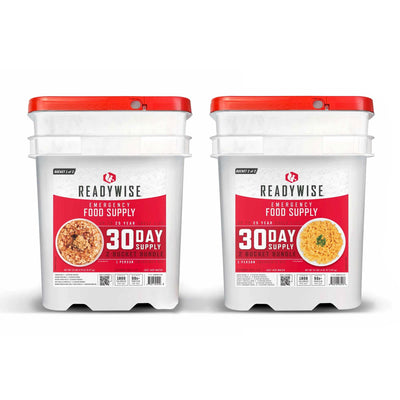When disaster strikes, being prepared with a reliable emergency food supply can make all the difference. Whether it's a natural disaster, power outage, or another unforeseen event, having food you can count on provides peace of mind in uncertain times. However, to be truly prepared, you need to know how long emergency food lasts and how to store it properly to maximize its shelf life.
Understanding the shelf life of different types of emergency food is crucial for effective planning. From canned goods to freeze-dried meals, the longevity of your supplies depends on how to store food long term, including factors like packaging and environmental conditions.
What Determines the Shelf Life of Emergency Food?
The shelf life of emergency food depends on several key factors, including the packaging method, the preservation process, and the storage environment. By controlling these elements, you can extend the shelf life of your emergency food supply and ensure it remains safe and nutritious when you need it.
One of the most significant factors is moisture—if food is exposed to too much moisture, it can spoil quickly. Temperature also plays a role: food stored in hot conditions will break down faster, while cooler temperatures help maintain food safety. Finally, exposure to light can degrade both the nutritional value and flavor of your food, so keeping it in a dark place is essential.
Types of Packaging
The type of packaging used for emergency food storage is vital to its longevity. Here's a breakdown of how different packaging impacts the shelf life of your emergency supplies:
- Vacuum-Sealed Bags: These airtight bags are excellent for preserving dried food by removing air, which limits spoilage and oxidation.
- Mylar Pouches: Known for their durability and moisture-proof qualities, Mylar bags are a popular choice for long term food storage. Combined with oxygen absorbers, they create an environment where food can last for decades.
- Canned Food: Cans provide a sturdy, sealed environment for food, protecting it from air and light. However, over time, canned goods can lose nutritional value and flavor, so it's important to rotate them regularly.
Average Shelf Life of Common Emergency Foods
Different types of emergency food have varying shelf lives. Below is a general guide to how long some of the most common survival foods to stockpile can last, depending on the packaging and storage conditions:
Canned Goods
Canned food like vegetables, fruits, and meats typically last anywhere from 2 to 5 years. While the canning process preserves food for a long time, the nutritional value and taste of canned goods can deteriorate as time passes. Regular rotation of these items is essential to ensure that your emergency food supply remains fresh.
Freeze-Dried and Dehydrated Foods
One of the best options for long term food supply is freeze-dried food. When stored correctly, freeze-dried meals and dehydrated food can last 20 to 25 years. This makes them a popular choice for emergency kits, as they maintain most of their nutritional value and flavor while offering an incredibly long shelf life.
Proper Storage Conditions for Maximizing Shelf Life
To get the most out of your emergency food supply, it's essential to store it correctly. Whether you're storing canned juices, starter kits, freeze-dried meals, or meat, keeping your food in a cool, dry, and dark place will significantly extend its shelf life. Items like canned goods and stored food should be placed in areas where they won't be exposed to moisture, light, or temperature fluctuations. This ensures the food retains its nutritional value for as long as possible. According to the Federal Emergency Management Agency, regularly inspecting your survival kit and food supplies is critical to being ready for any emergency situations.
Additionally, you want to watch out for damaged packaging, as compromised containers can lead to food spoilage or contamination. It's not just about storing food for emergencies—it's about making sure the food stays safe to eat. Items like canned juices or long-term freeze-dried meals can last years, but only if stored in optimal conditions. By maintaining a well-organized food storage area, you can ensure you'll be able to access high-quality supplies when needed.
In emergencies, you need to ensure that your food supply can support your family's calorie and nutritional needs. This is especially important during food shortages or other crises where resupply might not be possible. High-energy foods like meat or products from valley food storage offer long-lasting nutrition. For households with dietary restrictions, it's essential to stockpile diverse foods that can cater to everyone's needs. Choosing items with the most extended shelf life helps reduce the frequency of replacements, making long-term preparedness easier and less stressful over time.
Know When to Replace Your Emergency Food
No matter how well you store your food, it’s important to monitor expiration dates and rotate your stock regularly. Items like canned goods, with a shelf life of 2-5 years, should be checked more frequently than freeze-dried meals, which can last up to 25 years.
Make it a habit to inspect your emergency food supply annually, discarding anything with damaged packaging or signs of spoilage. By rotating your stock, you ensure that your food remains safe and nutritious, ready for use in any disaster or emergency situations.
















































































